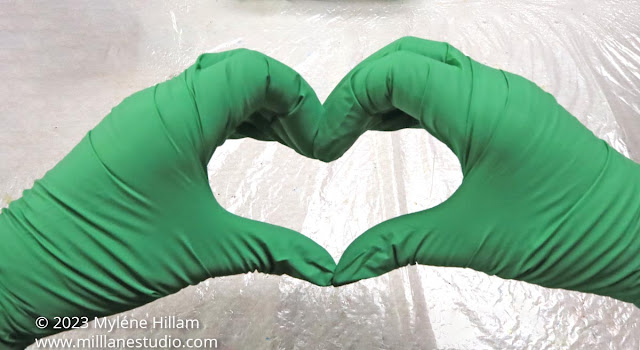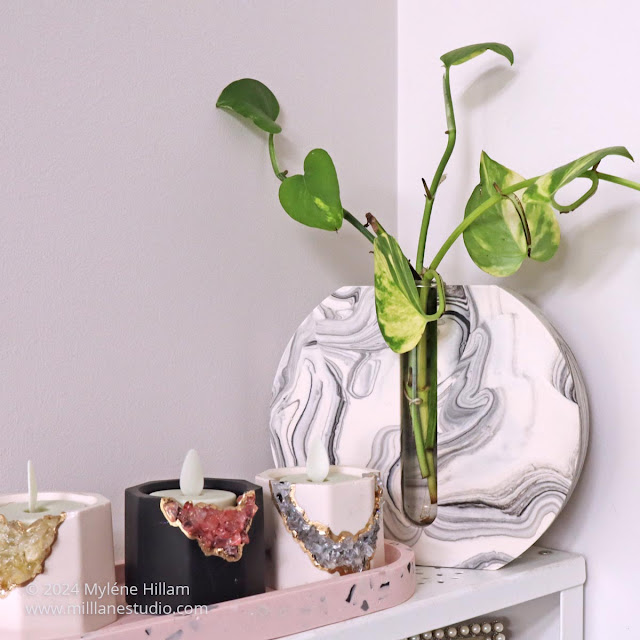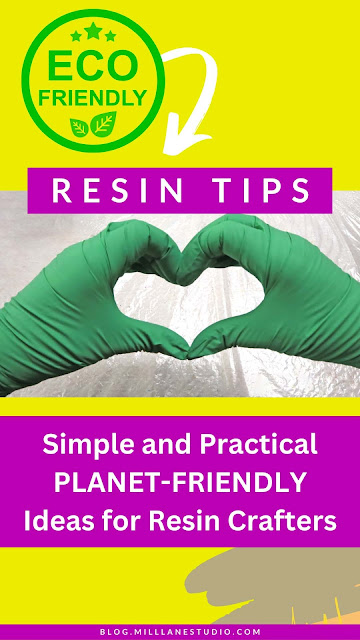Green is the new black! 🌎
As we become more aware of our carbon footprint, it's worth looking at how we practice our resin craft, not just for Earth Day, but every day.
As we become more aware of our carbon footprint, it's worth looking at how we practice our resin craft, not just for Earth Day, but every day.
I've recently implemented several changes in my studio to reduce waste. Many of the changes were easy to make. Some of them even saved money!
It all started when I ran out of graduated measuring cups and couldn't get any in a hurry. There was nothing for it; I had to clean the cups I was using so I could mix more resin. It turned out to be so easy. See how to do that here.
I raided the trash bag in my studio for some used cups (and was horrified at how many there were!). I soon discovered that once the resin had cured, it doesn't stick to the type of plastic these cups are made from. They were so EASY to clean that it became my standard practice!
I raided the trash bag in my studio for some used cups (and was horrified at how many there were!). I soon discovered that once the resin had cured, it doesn't stick to the type of plastic these cups are made from. They were so EASY to clean that it became my standard practice!
I didn't originally do this to be planet-friendly, but when I saw how many cups were in my trash bag, I realised I needed to reduce the waste my studio practices were producing. And once I started looking at it from that perspective, it became easier to see other ways I could reduce waste.
Single-use plastics aren't the only thing I eliminated from my studio.
Here are some other things I changed... and you can too! When we all do these simple and practical things, we CAN make a difference:
1. Re-use Your Cups - This is the easiest place to start
- Buy cups that are made of polypropylene (they have the number 5 inside the recycling triangle on the bottom of the cup).
- Or, use silicone cups. Resin doesn't stick to silicone either.
- Learn how to clean them so you can use them again and again.
2. Use Re-usable Stir Sticks
There are several options to choose from:
- Use plastic stirrers and clean them after use. Just wipe them clean with a baby wipe or tissue and denatured alcohol.
These 5" ones are my favourites. They're long enough to reach inside medium-sized cups. The added bonus with these stirrers is that they minimise the number of bubbles you incorporate as you mix the resin!
- Silicone stir sticks are easy to clean. Just let the resin cure and peel it off. They are a more expensive option than the plastic ones but they are longer, so they're good for larger batches of resin.
- Wooden stir sticks. Most people throw these away after a single use. But you don't have to! You can wipe off the excess resin, let the resin that's left on the stick cure, and use it repeatedly. Because it's now smooth, it will glide through the resin easily.
3. Wear Biodegradable Gloves
You need to keep your hands free from sticky resin when you're working with resin, and nitrile gloves are the best choice. They are stronger and more chemical resistant than latex gloves, but they are designed for single use.
Throwing away your gloves after each resin session is:
- costly and wasteful
- not good for the environment (regular nitrile gloves take years to break down)
- When they eventually break down, they break up into microplastic particles.
Enter BIODEGRADABLE nitrile gloves!
These are just as strong as regular nitrile gloves, but they break down in landfill 90% faster than conventional nitrile gloves and produce a humus-like organic material which is a natural plant fertiliser. How cool is that?!!
4. Use Bio-Resin or Acrylic Resin
YES, that's a thing!
- Bio-Resins are eco-friendly resins that are formulated from sustainable plant-based materials (renewable resources), or waste products from biofuel production.
There are different formulations for different resin techniques - some have a low exotherm with long cure times so they can be used for deeper pours. Others offer a choice of fast and slow hardeners for different types of resin work.
- There is also a new generation of water-based acrylic resin that is ideal for making homewares.
Here's a kit with everything you need to get started. This one makes terrazzo look-alike items. You can also marble with it to create wonderful home decor items.
One of the big benefits with eco resins is that they are safe for children to use so you can craft together. They also cure very quickly so children see a quick result.
5. Measure the Resin and Hardener Accurately
It goes without saying that you don't want to waste resin. However, if you're inaccurate with measuring out the two parts, you'll end up with either resin or hardener left over when you've finished your resin kit. With most resins, you cannot purchase Part A or Part B separately, so you will have to dispose of the leftover product at a chemical waste station.
N.B. Never place resin or hardener in the trash unless it has been mixed and cured.
6. Use Biodegradable Rubbish Bags
No matter how much we try to eliminate waste from our resin crafting, there will always be some trash to deal with. Here are two rubbish bag options that are considered environmentally friendly:
- PBAT bags. These are fully compostable. These can hold water without breaking down, yet they will break down in your home compost or landfill in just over 12 months!
- Plant-based plastic bags (PLA). These are not plastic at all! They are often made from sugar cane waste or cornstarch.
Expert tip: Free up your workspace by securing a rubbish bag with handles in an embroidery hoop and suspend it from your table with tablecloth clips.
7. Use Biodegradable Glitter
Make the switch from poly glitter to biodegradable glitter.
When I first came across these plant-based glitters, I was dubious that they'd sparkle the way plastic glitters do.
They definitely sparkle, but in a different way. Take a look at these resin pieces to see what biodegradable glitter looks like in resin.
If you're a soapmaker or wear body glitter, then biodegradable glitter is definitely for you. You can safely use them, knowing that once they enter the ecosystem, they will biodegrade quite quickly because they're plant-based.
For resin artists, these plant-based, biodegradable glitters are another way of reducing your carbon footprint. Less plastic means less pollution.🌎
By following these tips, your resin hobby will have a much lower impact on the environment, and you can continue to enjoy resin crafting while doing your bit to help the planet. Keep your eyes open for other opportunities to craft more responsibly.
Do you have any other eco-friendly tips that you use when doing your resin art? I'd love to hear them. Leave them below in the comments.
Pin These Eco-Friendly Resin Tips!

Subscribe to my email list and learn how to resin like an expert.








